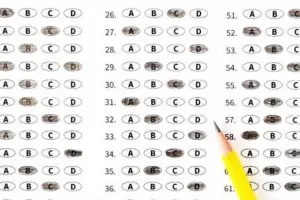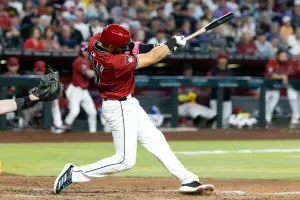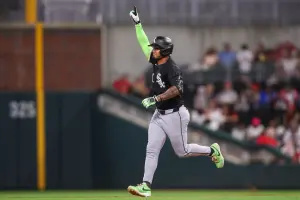
(*) SPECULATOR: Downside risk of league leaders
Pointing out the downside risk of mid-season league leaders isn't exactly a speculative exercise by nature: half-season leaders frequently don't hold their leader board position through the 2nd half of the season. We could point at just about any chart-topper and give reasons why they are unlikely to stay there, and be proven right a decent percentage of the time.
Still, there's value in going through and pointing out the warts among these leader board denizens. And to keep the exercise somewhat speculative in nature, we'll focus in on some softer factors that might make the sledding tougher in the 2nd half. Many of these guys have a recent Fact/Fluke analysis on file in Playerlink if you want the 80% analysis, so we'll focus on the other 20% of the picture.
Hitters
Chris Davis (1B, BAL) has been scalding-hot for three months now. A recent Fact/Fluke analysis offered the validating conclusion "Welcome to the penthouse, Mr. Davis." But not quite everything may be well here. When a player breaks out this dramatically, inevitably there is a cat-and-mouse cycle of adjustments being made between the hitter and the pitching community. Davis continued to mash in June, but did so with by far the shakiest plate skills of the season. Consider:
2013 bb% ct% Eye ==== ==== ==== ==== Apr 15% 72% 0.62 May 12% 76% 0.54 Jun 5% 62% 0.15
Walks often work as a trailing indicator with sluggers: once they establish themselves as power threats, they get less to hit. The reverse seems to be happening with Davis; or at least he is refusing to counter-adjust to the pitchers trying to work around him more. He hit another 12 HR in June, so it's hard to actually say something is amiss here. It's dangerous to over-interpret a one-month sample, but Davis will have a hard time maintaining his 1000+ OPS with June's supporting skills.
Adam Jones (OF, BAL) is suffering from an affliction similar to Davis'. Specifically, he's not taking any walks. Literally; his last walk came on May 18. Unlike Davis, his bottom line is being affected—Jones' .623 OPS for June was easily his worst of the season. Certainly, Jones is not the kind of hitter who pitchers would just openly challenge without fear of getting hurt. Rather, these numbers suggest that pitchers are successfully expanding the strike zone on Jones, learning that they can get him out off the plate. Jones has never been a patient hitter (career high bb%: 7% in 2009), but it does seem that there is a minimum standard for patience, and Jones is falling below it at the moment.
Jean Segura (SS, MIL) has taken the NL by storm in the first half, with a massively-valuable five-category explosion of value. The skills say that several components of this breakout our legit: specifically, xBA validates the BA, and his Spd is off-the-charts elite. The power has been the big surprise, of course. But there are other concerns: specifically, Segura's 326 AB is third in the NL. That's an awful lot of playing time, with the associated wear-and-tear, for a player who makes their living with their wheels. The opt-in aspect of Segura's breakout is an elevated SBO%. That shows no sign of softening yet (40% in June), but could be a first indicator of Segura wearing down in the summer heat.
Starling Marte (OF, PIT) is an easy mark for this exercise, as our Jeff Tomich identified in a May 16 Fact/Fluke piece. There, Jeff predicted imminent correction to Marte's hr/f and h%, both have indeed regressed significantly. What has continued to prop up Marte's value is his running game, as he added 8 SB in an otherwise-unremarkable June. But those SB came with 3 CS, and his season-long 22/8 SB/CS rate isn't good enough to afford him a consistent green light. His success rates in the minors were less than stellar as well. Marte's OBP is already plummeting from early-season levels, which has reduced SB opportunities. As the value proposition of those SB attempts gets less favorable for the Pirates, he may not even run as often when he does reach 1B.
Robinson Canó (2B, NYY)'s first half has been the opposite of Chris Davis' above. With the Yankee lineup plagued by early-season injuries, we speculated on our pre-season First Pitch tour that Cano might struggle to find RBI opportunities in the diminished Yankee lineup. That proved to not be much of an issue early on, but there is a trend that caught our eye. Compare this chart to Davis above:
2013 bb% ct% Eye ==== ==== ==== ==== Apr 8% 84% 0.53 May 8% 82% 0.45 Jun 17% 87% 1.50
To Cano's credit, he is having the opposite reaction of Davis: as pitchers decide they don't want to let him beat them, Cano is taking his walks and making more contact, at the expense of his power (.418 SLG in June was his lowest month since April 2012). And his hot start to July shows that his power hasn't been completely eliminated. Still, if pitchers collectively decide to work around Cano for the rest of the season, outbursts like we have seen from Cano this week will get harder and harder to put together.
Pitchers
Matt Harvey (RHP, NYM) threw 170 IP between the minors and majors in 2012. He had 117 thru June this year. That high IP total is the only downside of his unmitigated success this year. With the Mets a non-contender, how will they choose to limit Harvey's workload over the balance of the year? On the one hand, it's clearly a good choice for Harvey's longer-term outlook to do something. On the other hand, much like Stephen Strasburg a year ago, there were more options available earlier in the season, and by waiting until July to do anything, the Mets have painted themselves into something of a corner.
Harvey's IP pace is already too high to be managed by simply skipping a start here and there, or cutting a few outings short. 12-14 more starts at 6 IP/start puts him at 200 IP, and an argument can be made that Harvey's innings cap should be set lower than that. Before this issue garners widespread attention, H2H and Scoresheet players might look to cash in Harvey now, before his value plummets in formats that place a high value on September performance.
Justin Masterson (RHP, CLE) has been nearly perfect in terms of consistent performance, as evidenced by an 83%/0% PQS DOM%/DIS% split. Like Harvey, though, the downside of that sort of consistent performance every five days is that Masterson has not taken a single early shower. Only once has he failed to pitch six full innings, and his lowest pitch count for the season is 92. He has gotten an extra day of rest five times in his 18 starts, but that seems like just a minor concession to his mounting workload. Masterson has a case for an All-Star bid, if he works in the game or if the Indians try to juggle their rotation to keep him on a regular turn, Masterson seems primed for a 2nd-half meltdown similar to last year's (1H: 4.09 ERA, 2H: 5.77 ERA... although the skills gap wasn't nearly that bad).
Lance Lynn (RHP, STL) came unglued at right about this point last year, as he ran out of gas and got moved to the bullpen late in the season after a terrific first half. He eventually righted himself down the stretch, but conditioning seemed to be an issue for the big righty. He responded by losing a significant amount of weight in the offseason. In theory, he should now be in a better position to carry his workload through the second half. But until we see him actually do that, it's fair and reasonable to have questions about whether he can pull it off. The fact that he has been struggling since the weather warmed up doesn't inspire confidence on this front, either. As such, the only way to totally eliminate that risk is to sell him now, assuming there is a full-value buyer to be found.
Addison Reed (RHP, CHW) is a bit of an outlier among the current MLB saves leaders, in that he pitches for a bad team. As Patrick Davitt's recent research demonstrated, save totals are generally higher on good teams. Reed has a good save total right now, but the White Sox are by no means a good team (and they could get worse at the trade deadline). Reed is on a near-40 save pace right now, but may finish the season well short of that elite total.
Next week: Our speculative all-2nd half team
The Speculator is not designed to makes definitive assertions about the future; rather, it is designed solely to open readers' eyes to possibilities they may not have previously entertained, and in doing so, provide a different perspective on the future. Many of the possibilities will be of the "out on a limb" variety. All are founded on SOME element of fact. But none should be considered any more than 20% percentage plays.








